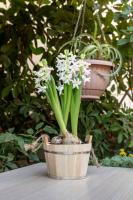How to Plant Pear Trees with Optimal Spacing
Pear trees are easy to cultivate and provide delicious fruit for years to come. However, when it comes to planting pear trees, appropriate spacing is crucial to ensure healthy growth and optimal yield. In this article, we will discuss how to plant pear trees with the right spacing to achieve the best possible results.
Why Spacing Matters
Spacing is a critical factor to consider when planting pear trees. A proper distance between the trees ensures that they receive enough sunlight, nutrients, and water to thrive. Overcrowded pear trees can lead to weak growth, smaller fruits, and even disease or pest problems. By contrast, planting pear trees too far apart can reduce pollination and yield. Therefore, it is vital to find the perfect balance when planting pear trees and ensure optimal spacing.
Choosing the Right Site
The first step in planting pear trees with optimal spacing is to choose the right site. Pear trees require full sun exposure, well-drained soil, and adequate air circulation to thrive. Avoid planting pear trees in low-lying areas that may collect water and increase the risk of disease. When selecting a location, consider the mature size of the tree and the space it will require. A general rule of thumb is to provide enough space for the tree to grow to full size without overcrowding or causing problems with adjacent trees or buildings.
Determining the Spacing
Typically, pear trees can be planted between 12 to 20 feet apart, depending on the variety and rootstock. However, there are other factors to consider, such as soil quality, irrigation, and pruning practices. For example, if you plan to use drip irrigation or high-density planting methods, you may need to plant trees closer together than if you are using conventional irrigation or planting methods. Consult with a local nursery or orchard expert to determine the best spacing for your specific situation.
Planting Pear Trees with Optimal Spacing
Once you have chosen the site and determined the spacing, it's time to plant your pear trees. Here are some general guidelines:
Dig a hole that is twice as wide and as deep as the root ball of the tree.
Remove rocks, weeds, and other debris from the soil and add organic matter, such as compost or aged manure.
Place the tree in the hole, making sure that the soil level around the trunk is the same as it was in the pot. Spread the roots out evenly.
Backfill the hole with soil and pack it firmly around the tree to remove any air pockets.
Water the tree thoroughly and add a layer of mulch around the base, but not touching the trunk.
Stake the tree if necessary to prevent it from tilting in strong winds or heavy rain.
Caring for Pear Trees
To ensure healthy growth and optimal yield, regular care is essential for pear trees. Here are some tips:
Water the tree regularly, especially during the first growing season.
Fertilize the tree annually with a balanced fertilizer, according to the package instructions.
Prune the tree in late winter or early spring to remove dead or diseased branches, improve air circulation, and control its size and shape.
Protect the tree from pests and diseases by monitoring it regularly and using appropriate chemical or organic treatments if necessary.
Conclusion
Planting pear trees with optimal spacing is critical to achieving healthy growth and optimal yield. Choosing the right site, determining the spacing, and planting the tree correctly are the initial steps to follow. Regular care, including watering, fertilization, pruning, and pest management, is also necessary. By following these steps, you can enjoy the pleasure of growing your pear trees and harvesting delicious fruit for years to come.

 how many times do yo...
how many times do yo... how many planted tre...
how many planted tre... how many pine trees ...
how many pine trees ... how many pecan trees...
how many pecan trees... how many plants comp...
how many plants comp... how many plants can ...
how many plants can ... how many plants and ...
how many plants and ... how many pepper plan...
how many pepper plan...































